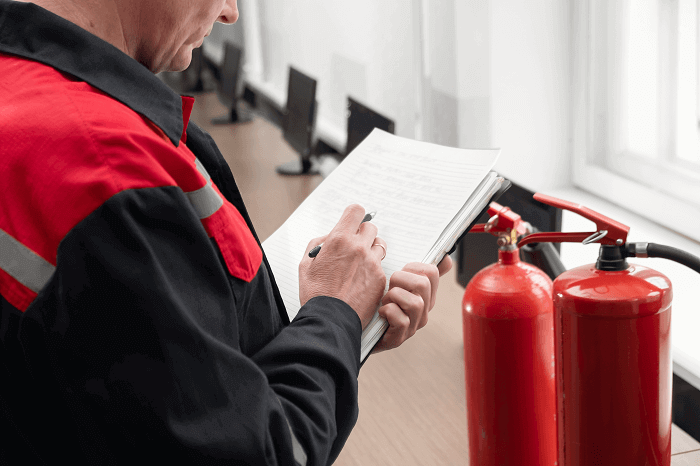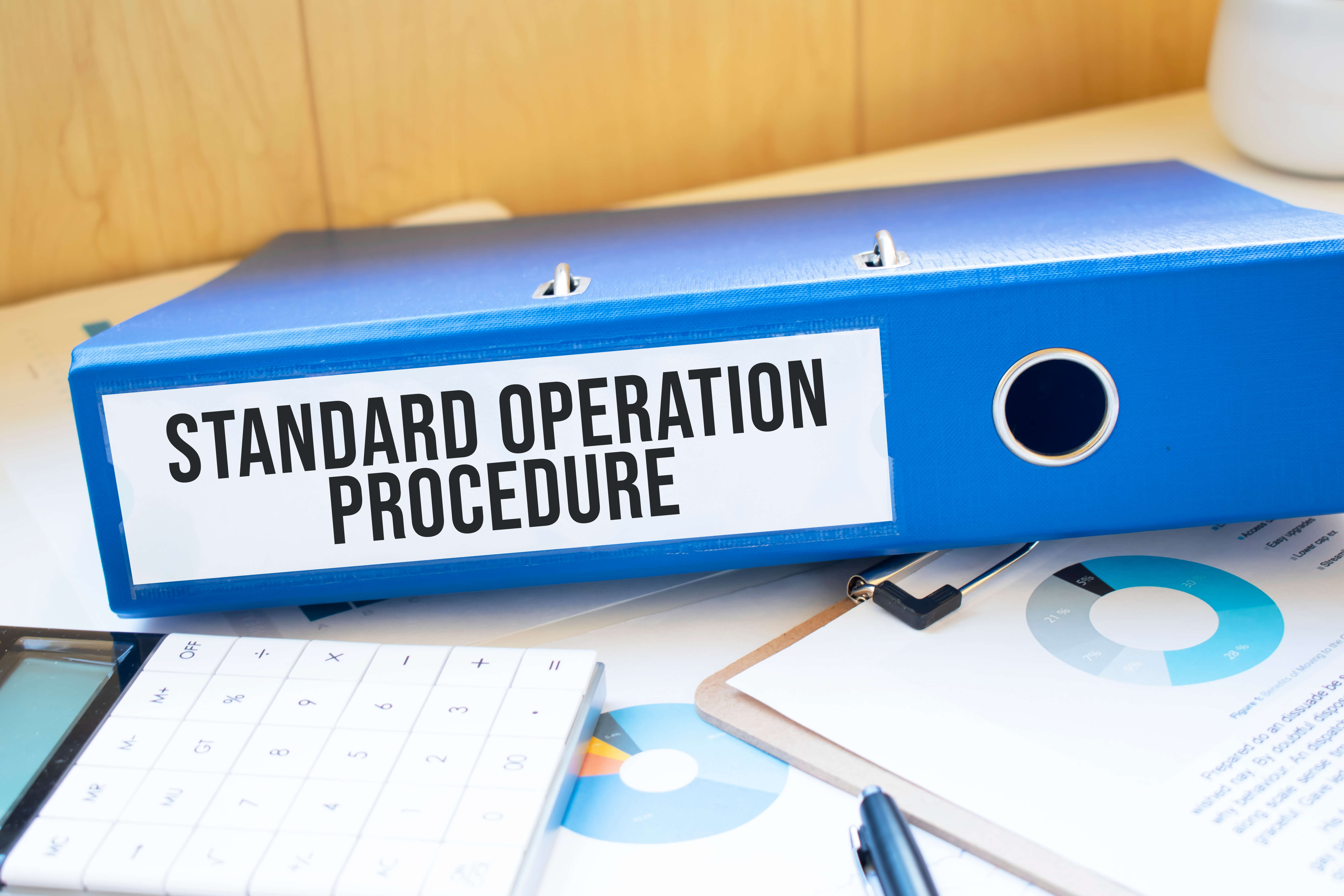Keeping your employees safe should be one of your main concerns as an employer. This includes implementing fire safety plans and carrying out the appropriate fire risk assessments.
In this article, we are going to look in detail at what you should be including in your risk assessments and who they should be carried out by.
If you need immediate support in improving the fire safety of your building, get in touch with one of our Health and safety experts on 0800 470 2753.

What is a fire risk assessment?
Fire risk assessments are reviews that assess the fire risks within a premises and out in the recommendations to reduce or eliminate the risks.
You should use your fire risk assessment to understand what risks are present in your workplace and how they could potentially cause harm to your employees and anyone who visits your premises.
Why should I do a fire risk assessment?
Fire risk assessments are a legal requirement and if you have more than five employees this needs to be written down and recorded.
As an employer, you need to ensure that the competent person completes the fire risk assessment.
Who should carry out a fire risk assessment?
The person who completes your fire risk assessment may vary depending on what size premises you have, business activities and potential hazards.
Large businesses
If you own a large business or a business that has complex moving parts, you may benefit from an outsourced professional help. They can ensure that you've covered all your bases and that all the potential hazards have the appropriate measures or equipment provided to your employees and workers.
Croner's fire safety experts are on hand to help your business put together your risk assessment and regularly conduct fire risk assessment reviews.
Small businesses and organisations
If you own a small and simple business you may be able to carry out the fire risk assessment yourself, or nominate the responsible person within the business to carry out the assessment. The person who completes the fire risk assessment must be competent to do so. You may still benefit from having it completed externally, as a competent fire risk assessor might spot more hazards and advice on what measures should be put in place as they've gone through the relevant training.
Heritage building
Museums and heritage buildings should take advantage of outsourcing their fire risk assessment duties. As these buildings aren't built in the same way modern buildings are, meaning the potential fire hazards could be hidden or measures that you've put in place might not be as effective.

What does a fire risk assessment cover?
Typically, a fire risk assessment will cover your building including stairwells, entrance halls, external walls and front doors to common areas and residential areas.
You should include what measures you've put in place to prevent a fire or reduce the spread of a fire, should one break out. This could include, but is by no means limited to:
- Ensure 'No Smoking' signs are present in the relevant areas.
- Conducting regular PA testing on all electronics and including plug sockets and lights.
- Regularly carry out fire door checks.
- Regular inspections of fire extinguishers and sprinklers to ensure they remain effective.
- Review emergency plans in case of fire and clear escape routes.
- Ensure fire alarms are effective and working.
5 steps for fire risk assessment
When you start conducting a fire risk assessment there are five steps that you can follow.
Fire hazard
Look around your business premises for any fire hazards that could be present. This could be anything that has the potential to start a fire. You should consider:
- Smoking
- Arson
- Housekeeping
- Vehicles
- Contractors
- Cooking
- Electronics
- Heating
If you're struggling with this step, ask yourself the following questions.
- Have you found anything that could start a fire or burn?
- How could a fire start on your premises?
- Do you have any heat processes? (including welding and grinding)
- Do you have heaters, computers and electronics?
- Do you have a designated smoking area?
People at risk
You should consider the people who are on your premises. Are there any young people, disabled workers or night workers who could be carrying out work that is at risk of fire or affected by a fire.
Evaluate and act
Once you've evaluated the potential hazards in your workplace you should consider how you are going to act and what measures you're going to put into place.
Ask yourself:
- Do you have enough escape routes and planned exits?
- Do you have enough fire exit signs?
- Do you require emergency lighting?
- Do you need a fire alarm system?
- Are fire extinguishers needed? Do you know where they should be located and staff trained to handle them?
- Who is responsible for calling the fire and rescue service?
- Do you have a fire safety plan? and what is it? Are your employees aware of it?
When completing a fire risk assessment, correct guidance should be followed and referenced. The guidance will specify what is deemed adequate for certain measurements, such as escape distances, occupancy rates and door widths. This is why it is important that a competent person completes the assessment.
Record, plan and train
You should ensure that you record your findings from your risk assessment (a legal requirement if you have over 5 employees).
This will help you to track what measures you've put in place, and when you come to review the measures at a later date, you can assess if the measures are still effective or if they need to be adapted. At this stage you should also look into ensuring your employees and workers are trained in what to do if a fire breaks out and what process they should follow.
Consider:
- Formulating an action plan that will reduce fire hazards and improve fire safety.
Review
As we've mentioned, you should ensure that you are regularly reviewing your fire risk assessment. As processes change so do the associated risks, you should ensure that if you change a process or make significant changes that you update the fire risk assessment appropriately.
You should also update your risk assessment if you've experienced a fire or a near miss, changes to the levels of stock you store, if you've started to store dangerous chemicals or substances, is occupancy numbers have changed, and if the fabric or layout of the building has changed.

Are there any legal guidelines with fire risk assessment
As an employer, there are legal guidelines that you need to follow to ensure that your fire risk assessments are effective. We've put together some of the guidelines that you must follow.
Must be reviewed regularly
You should ensure that you're regularly reviewing your fire risk assessment, but if you have changed an element of the process or the workplace, you should ensure that your fire risk assessment reflects those details.
If there aren't any changes in the building or process, you should look to review your fire risk assessments every twelve months.
Do I need to write my fire risk assessment down?
As we've stated, if your premises have five or more workers or residents, you should ensure you have a written fire risk assessment.
Although you don't need to have a written record of the risk assessment, its recommended that your fire risk assessment is written down. This will make it easier to refer back to later on.
Usually, a fire risk assessment is documented in a way that meets a certain template, called PAS79, and this is the standard that Croner consultants use when completing assessments.
Must record the findings and action plan
If you've established the safety measures are needed on your premises, you should keep them recorded. When you come to review the measures at a later date you will be able to assess whether the measures are effective and fit for purpose.
They should also be recorded for your employees or workers as they will be able to use them in training and refer to them if a fire were to break out.

Is there a penalty for not having a risk assessment?
Without the appropriate fire risk assessment and measures in place, your business could find themselves facing substantial fines and potential prison sentences.

Get expert advice
At Croner, our experts have over 80 years of experience, advising on HR, Employment Law and Health & Safety. We have dedicated Health and Safety advisors who are on hand to help you put together your fire risk assessments.
Get in touch on 0800 470 2753
Related resources
Categories
- Business Advice
- Contracts & Documentation
- Culture & Performance
- Disciplinary & Grievances
- Dismissals & Conduct
- Employee Conduct
- Employment Law
- End of Contract
- Equality & Discrimination
- Health & Safety
- Hiring & Managing
- Leave & Absence
- Managing Health & Safety
- Moving
- Occupational Health
- Pay & Benefits
- Recruitment
- Risk & Welfare



